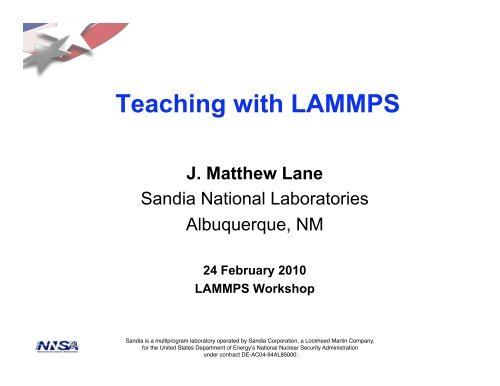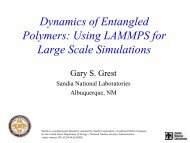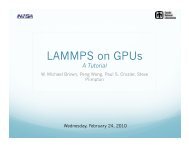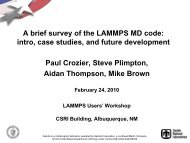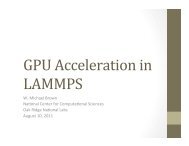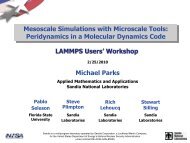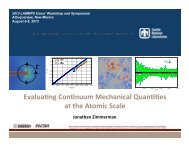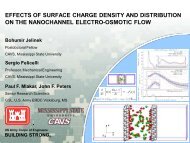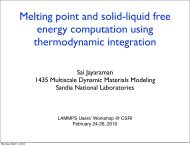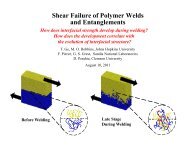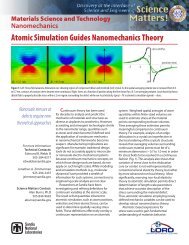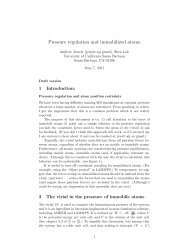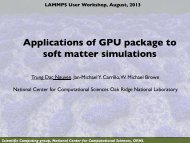Teaching with LAMMPS - Sandia National Laboratories
Teaching with LAMMPS - Sandia National Laboratories
Teaching with LAMMPS - Sandia National Laboratories
Create successful ePaper yourself
Turn your PDF publications into a flip-book with our unique Google optimized e-Paper software.
<strong>Teaching</strong> <strong>with</strong> <strong>LAMMPS</strong>J. Matthew Lane<strong>Sandia</strong> <strong>National</strong> <strong>Laboratories</strong>Albuquerque, NM24 February 2010<strong>LAMMPS</strong> Workshop<strong>Sandia</strong> is a multiprogram laboratory operated by <strong>Sandia</strong> Corporation, a Lockheed Martin Company,for the United States Department of Energyʼs <strong>National</strong> Nuclear Security Administrationunder contract DE-AC04-94AL85000.
<strong>LAMMPS</strong> scope and examplesLarge-scale Atomic/Molecular Massively Parallel Simulator• <strong>LAMMPS</strong> is open-source (GNU Public License)• ~50,000 <strong>LAMMPS</strong> downloads since Sept 2004.• Three primary communities are supported by forcefields, boundary conditions and diagnostics:– Biomolecules and polymers (soft materials)– Solids materials science– Mesoscale to continuum10 -15 s Time yearsQMÅMESOFEADesignMDDistance m
Agenda• Discrete Element Modeling Course at Texas• TMS/MatDL and education for ICME-related codes• Survey of current efforts• Discussion
Discrete Element Modeling Course at Texas• Course Description/Goals Graduate-level semester course <strong>with</strong> modular lectures on the fundamentals of MD & MC <strong>LAMMPS</strong> (www.lammps.sandia.gov) will be the platform for demos & student homework This course should equip students to use and develop/modify <strong>LAMMPS</strong> for research• Strategy and Format One lecture per week by a <strong>Sandia</strong> staff member or UT faculty over 15-week semester Major group project using <strong>LAMMPS</strong> to investigate a problem in materials science orengineeringApplication areas: MD algorithms, colloid suspension dynamics, granular flow, predictive properties ofsystems at equilibrium (e.g. phase change, microstructure), etc. Class size in the 15-25 students range – all masters level• Short-term schedule & Long-term vision First course offering will be Spring 2011. At Texas, the course will eventually be taught by senior grad student, <strong>with</strong> faculty advising. The course will eventually be offered to <strong>Sandia</strong> staff, post-docs and interns, as well.
Proposed syllabus (draft)Week 1: Overview of MD & MC. Approachable problems, length/time scales, scaling argumentsMOLECULAR DYNAMICSWeek 2: <strong>LAMMPS</strong> fundamentals/overview, tutorials, syntax and hands-on.Week 3: Model system initialization tools. Visualization tools. Group project discussionWeek 4: Numerical methods and algorithms for solving discrete Newton’s equations of motion.Time integration, Ensemble averaging, Boundary conditions, Thermostat and barostat methodsWeek 5: Methods for solvent systemsBrownian dynamics, Fully-explicit solvent, Dissipative particle dynamics, Stochastic rotation dynamicsWeek 6: Property concepts and calculationsDiffusion, Viscosity, Surface tension, Phase separation, Melt temperaturePAIRWISE AND MULTIBODY INTERACTIONSWeek 7-8: Particle potentials through applications.Colloidal and nanoparticle suspensions, solid mechanics, granular systemsMONTE CARLOWeek 9: Sampling TechniquesWeek 10: Phase EquilibrationWeek 11: Property Calculations – e.g. equations of stateWeek 12: Demonstration problems. e.g., Aspherical particles. Other advanced topics.PROJECT PRESENTATIONSWeek 13-15: Project completion. Group presentations.
TMS/MatDL and ICME-related codes• ICME concept and TMS investment Integrated Computational Materials Engineering Hierarchy of material codes <strong>with</strong> common I/O TMS funds projects which promote ICME goals through education• Materials Digital Library (MatDL) Program Funded through NSF and TMS Neutral, central location for materials science codes Store, manage and vet educational resources for participating codes Pre-compiled linux boot CDs <strong>with</strong> standard distributions<strong>LAMMPS</strong> participated in a roundtable <strong>with</strong> faculty at the TMS annualmeeting focused on integrating material science codes intoappropriate undergraduate courses
Survey results – user experience1. Have you used <strong>LAMMPS</strong> in an educational setting?No, not a single respondent had used <strong>LAMMPS</strong> to teach.2. Are you contemplating using <strong>LAMMPS</strong> foreducation in the future?Yes, 8 of 10 of responses. 3 had concrete near-term plans.3. Have you developed classroom demonstrations,examples, assignments or student projects whichutilize <strong>LAMMPS</strong>?No one had done any resource development.
Survey results – user experience (cont)• Are there specific issues which might complicateusing <strong>LAMMPS</strong> in your teaching?Access to clusters, Students unable to compile code,Students expect GUI. However, most say no obstacles.• Would you be interested in additional resources forteaching <strong>with</strong> <strong>LAMMPS</strong>?9 of 10 responses sought additional resources for teaching.Student project ideas, and adaptable examples were themost popular.
Using <strong>LAMMPS</strong> for educationPRO• Open source (GPL) = freeCON• No GUI, or visualization• No coding necessary• Large body of potentials• Powerful and flexible• High student return on investment• No version control• Significant startup investment forfaculty – materials development• Significant startup investment forstudents – compile and link• Established user community• Available for Linux, Mac OS X, andnow Windows binary
Discussion• Interest level? Is there a critical mass to proceed?• Is this a good direction for <strong>LAMMPS</strong>?• Where to start? What is the role of <strong>Sandia</strong> staff?What is the role of <strong>LAMMPS</strong> users & faculty?• Particularly interested? Email - jlane@sandia.gov


